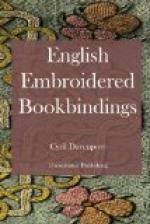If early bindings in satin are rare, still rarer is the use of silk. One example worked on white ribbed silk still remains that belonged to Queen Elizabeth. It measures 4-3/4 by 2-3/4 inches, and in its time was no doubt a very decorative and interesting piece of work, but it is now in a very dilapidated state, largely due to improper repairing. The book has actually been rebound in leather, and the old embroidered sides stuck on. So it must be remembered that my illustration of it is considerably restored. The design, alike on both sides, is all outlined with gold cords and twists of different kinds and thicknesses, and the colour is added in water-colours on the silk. In the centre is the royal coat-of-arms within an oval garter ensigned with a royal crown, in the adornment of which a few seed pearls are used, as they are also on the ends of the garter.
Enclosing the coat-of-arms is an ornamental border of straight lines and curves, worked with a thick gold twist, intertwined with graceful sprays of double and single roses, outlined in gold and coloured red, with buds and leaves. A few symmetrical arabesques, similarly outlined and coloured, fill in some of the remaining spaces. The work on this book, a New Testament in Greek, printed at Leyden in 1576, is like no other; but the general idea of the design, rose-sprays cleverly intertwined, is one that may be considered characteristic of the Elizabethan embroidered books, as it frequently occurs on them. The use of water-colour with embroidery is very rare, and it is never found on any but silk or satin bindings, generally as an adjunct in support of coloured-silk work over it, but in this single instance it is used alone.
Seventeenth-Century Embroidered Books.
The books described hitherto have been specimens of rare early instances, but in the seventeenth century there is a very large field to choose from. Small books, mostly religious works, were bound in satin from the beginning of the century until the time of the Commonwealth in considerable numbers; so much so, in fact, that their value depends not so much upon their designs or workmanship as upon their condition.
It is generally considered that embroidered books are extremely delicate, but this is not so; they will stand far more wear than would be imagined from their frail appearance. The embroidered work actually protects the satin, and such signs of wear as are visible are often found rather in the satin itself, where unprotected, than in the work upon it. In many cases a peculiar appearance, which is often mistaken for wear, is seen in the case of representations of insects, caterpillars, or butterflies particularly. These creatures, or parts of them, appear to consist only of slight stitches of plain thread, suggesting either that the work has never been finished, or else that the finished portions have worn away. The real fact is, however, that these places have been originally worked with small bright pieces of peacock’s feather, which have either tumbled out or been eaten away by minute insects, a fate to which it is well known peacocks’ feathers are particularly liable.




